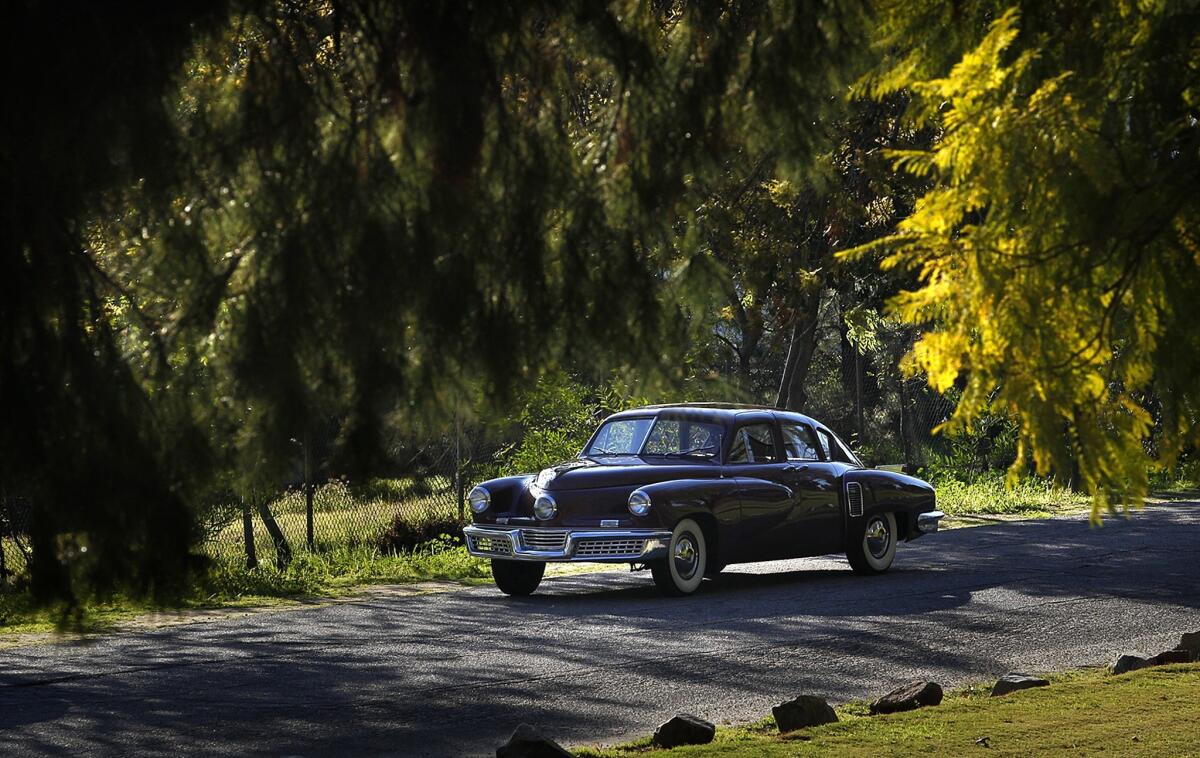Rare Tucker 48 formerly owned by George Lucas headed to auction

- Share via
Martyn Donaldson leans hard against the hulking 1948 Tucker 48 and rolls it out of his small restoration shop in Pacoima.
Although the color on its build sheet is listed as maroon, the midafternoon sun reveals a metallic luster in the showroom quality paint job. Electric raspberry, Donaldson calls it.
This Tucker 48, just the third in a total run of 51, has spent the better part of three years at Donaldson’s shop. The Tucker expert thoroughly restored the car’s engine and electrical system, and installed a new transmission and interior. Before it arrived in Pacoima, the Tucker’s chrome and body were restored to original specifications at a shop in nearby Sun Valley.
Photos: Rare 1948 Tucker 48 “Torpedo” headed to auction
Now that this 48 is as fresh as it was when it rolled out of the Tucker factory in Chicago in 1948, it will head to Amelia Island, Fla. RM Auctions announced Thursday that it will put the car on the auction block at its Amelia event March 9. The company estimates the car, which counts George Lucas among its former owners, will sell for $1.5 million to $1.9 million.
Photos: Highlights of the Amelia Island auctions
The Tucker 48, also known as the Tucker Torpedo, is better known for what it didn’t do than what it did do. The cars were the brainchild of Preston Tucker, who saw an opportunity in postwar America to build something innovative when the Big Three were still recovering from the war effort and building outdated cars. Unfortunetaly, the Tucker never got the chance.
“Tuckers almost had a mystical quality to the innovative design and creativity that went into creating them,” said McKeel Hagerty, owner of a classic car insurance and valuation company.
“A lot of the ideas [Tucker] came up with were very cutting edge,” Hagerty said.
The technologies Tucker envisioned on his rear-engine car included disc brakes, fuel injection and the car’s most distinctive feature, a center-mounted headlight that would turn with the steering wheel. Unfortunately, the realities of production meant only the headlight and the engine placement came to fruition.
Production cars did come with innovative safety features like a windshield that would pop out in a crash, a padded dashboard when most were metal, and a space by the front passenger’s feet where they could duck before an accident (this was before seatbelts were required).
After his initial engine design proved a failure, Tucker bought a light-aircraft engine company and retrofitted a helicopter engine to work in his cars. Thus, a water-cooled, 335 cubic-inch, 166-horsepower flat six-cylinder engine sits behind the rear passengers.
The transmission is a four-speed vacuum-electric pre-selector transmission borrowed from Cord automobiles built in the late 1930s. To use this type of transmission, the driver first selects the next gear he or she wants via a small lever mounted to a stalk on the steering column. When the driver is ready for the shift itself, he or she pushes the foot pedal to engage it. Despite these features, and the car’s progressive styling -- including suicide doors for the rear passengers -- the company survived only long enough to build and sell 50 Tucker 48’s and a prototype.
Before large-scale production of the car could commence in 1948, Preston Tucker and several of his executives were indicted by the Securities and Exchange Commission on various mail fraud and conspiracy charges. By the time they were acquitted of all charges in 1950, the public’s interest in the cars had waned and the company folded.
The rise and fall of Tucker -- the man and the company -- was chronicled in the 1988 film “Tucker: The Man and His Dream,” starring Jeff Bridges. Francis Ford Coppola was the director and George Lucas was the executive producer. Coppola and Lucas each bought Tucker 48s. Lucas later sold this model to the current owners, who then commissioned its restoration.
Because of the rarity of the car and the technology featured on Tuckers, U.S. collectors are starting to value them more than almost any other postwar American car, Hagerty said.
“If you’re building a 20- or 30-car, ultimate collection, this could be in it,” Hagerty said. “It’s a really special automobile.”
Also driving value is the fact that Tuckers don’t come up for public sale often, Hagerty said.
Donaldson echoed this sentiment. “When one becomes available, if you want one, you buy it,” he said. “You can’t get picky.”
So what kind of experience will this Tucker’s next owner get for his millions?
Donaldson is happy to demonstrate and hops in the driver’s seat. The six-cylinder engine needs a bit of coaxing before it coughs to life. After a few revs to clear its throat, the Tucker 48 settles down to a low, throaty idle. The exhaust note has more of a rough voice coming out of the six tailpipes than you might expect from a six-cylinder car from its day.
A brief ride in the Tucker 48 on the streets found the car to be an engaging, if somewhat bouncy cruiser. The large bench seat in the front has springs like your grandmother’s couch, and thus you bob up and down when the car hits a bump.
The front passenger seat has acres of legroom; there’s no dashboard to speak of, save for the padded frame around the windshield. This means even people 6 feet and taller have to fully extend their legs to touch the carpeted firewall. Meanwhile, the rear seats offer the same spaciousness and bouncy ride.
Whether the new buyer will take it out for a drive is unknown; Donaldson says many existing Tuckers have been museum pieces for much of their lives. Yet the car would be just as appropriate for car shows around the country. “It’d be more than welcome at a Concours,” Hagerty said. “It would have a crowd of people around it the whole time.”
And if anyone asks, that’s not maroon. It’s electric raspberry.
ALSO:
L.A.’s top cars and trucks by sex
Amelia Island auction draws some doozies -- and a Duesenberg SJ







